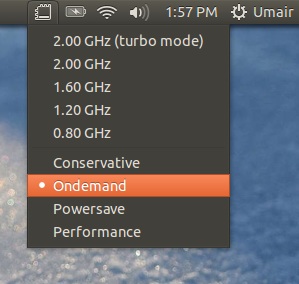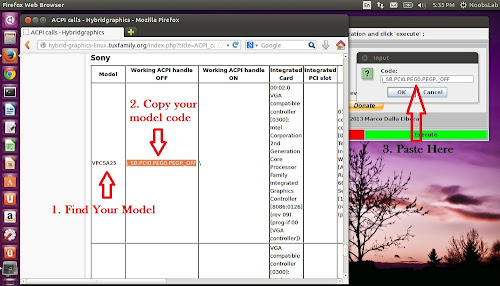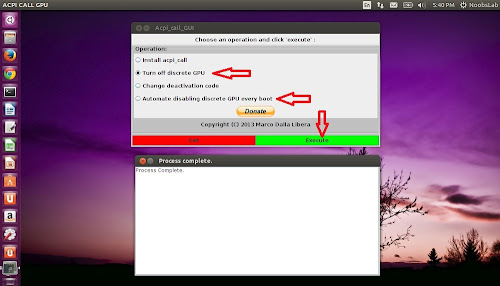Enable Laptop Mode and other tweaks to improve battery for Ubuntu 15.04 Vivid/14.10 Utopic/14.04 Trusty/12.04/Linux Mint 17.x/17/13/and other related Ubuntu derivatives
Managing battery power in Linux since kernel 3.x is bit difficult, many users face quick battery drain in Linux than other operating systems. There are tools available to manage power of laptop to improve battery life, previously I wrote improve battery with TLP power management. Now I burought other tools for you to improve battery life, if TLP doesn't fit to your needs. This script does all tweaks automatically within your system.

First of all the most popular utility Laptop Mode Tools which saves power by spinning down hard drives, and in addition, it can be configured to tweak all sorts of other power-related things. The core feature of Laptop Mode Tools is that it controls the "laptop mode" feature of the Linux kernel. In addition this tools can tweak things like readahead settings, hard drive power management settings, CPU frequency scaling settings, CPU throttling settings, DPMS settings, terminal blanking settings, and LCD brightness settings. It also supports various other power management features, such as starting and stopping daemons depending on power mode, automatically hibernating if battery levels are too low, and adjusting terminal blanking and X11 screen blanking.
Second tweak is to stop access to HDD for log files. If you are in single user system, probably you don't need log file like when this directory/file was accessed last time.
Third tweak is about to create virtual ram (swappiness), so whenever ram is out of space system is going to use virtual ram. This allows system to use all memory when memory is full use virtual ram, so in this case system won't bother your HDD.
Forth tweak is about to create ram drive for temp filesystem. This tweak moves temporary files from HDD to RAM then system won't hit HDD for temp file. The system touches HDD the more we save battery.
Fifth tweak is a utility called indicator-cpufrequency, It allows user to set specific amout of CPU to system or CPU on demand. In such a way it can help user to save battery by using 'power on demand'.
Download and run script for battery tweaks in Ubuntu 15.04/14.10/14.04/12.04/Linux Mint 17.x/16/13/and other related Ubuntu derivatives open terminal and enter following commands:
Use this one command to undo/uninstall tweaks open terminal and enter following command:
Dual GPU Tweak:
This tweak is only for those who has dual GPU in their Laptop. If you are not using other GPU for example Nvidia, AMD Catalyst, you can disable them in order to save battery.
So there is an open source program written in java. It disables discrete GPU which is not in use to save battery time.
This is a java program that allows the user to simply install acpi_call kernel module via graphic Interface, and also provides an useful script that automatically recompiles the kernel after each update.
Program features:
Also see this video tutorial.
To install Acpi-Call-GPU Utility in Ubuntu/Linux Mint/other Ubuntu derivatives Open Terminal (Press Ctrl+Alt+T) and copy the following commands in the Terminal:
This program requires java installed on the system.
To uninstall this program:
That's it
Managing battery power in Linux since kernel 3.x is bit difficult, many users face quick battery drain in Linux than other operating systems. There are tools available to manage power of laptop to improve battery life, previously I wrote improve battery with TLP power management. Now I burought other tools for you to improve battery life, if TLP doesn't fit to your needs. This script does all tweaks automatically within your system.

First of all the most popular utility Laptop Mode Tools which saves power by spinning down hard drives, and in addition, it can be configured to tweak all sorts of other power-related things. The core feature of Laptop Mode Tools is that it controls the "laptop mode" feature of the Linux kernel. In addition this tools can tweak things like readahead settings, hard drive power management settings, CPU frequency scaling settings, CPU throttling settings, DPMS settings, terminal blanking settings, and LCD brightness settings. It also supports various other power management features, such as starting and stopping daemons depending on power mode, automatically hibernating if battery levels are too low, and adjusting terminal blanking and X11 screen blanking.
Second tweak is to stop access to HDD for log files. If you are in single user system, probably you don't need log file like when this directory/file was accessed last time.
Third tweak is about to create virtual ram (swappiness), so whenever ram is out of space system is going to use virtual ram. This allows system to use all memory when memory is full use virtual ram, so in this case system won't bother your HDD.
Forth tweak is about to create ram drive for temp filesystem. This tweak moves temporary files from HDD to RAM then system won't hit HDD for temp file. The system touches HDD the more we save battery.
Fifth tweak is a utility called indicator-cpufrequency, It allows user to set specific amout of CPU to system or CPU on demand. In such a way it can help user to save battery by using 'power on demand'.
Download and run script for battery tweaks in Ubuntu 15.04/14.10/14.04/12.04/Linux Mint 17.x/16/13/and other related Ubuntu derivatives open terminal and enter following commands:
Use this one command to undo/uninstall tweaks open terminal and enter following command:
Dual GPU Tweak:
This tweak is only for those who has dual GPU in their Laptop. If you are not using other GPU for example Nvidia, AMD Catalyst, you can disable them in order to save battery.
So there is an open source program written in java. It disables discrete GPU which is not in use to save battery time.
This is a java program that allows the user to simply install acpi_call kernel module via graphic Interface, and also provides an useful script that automatically recompiles the kernel after each update.
Program features:
- Install the acpi_call kernel module (kernel would be recompiled automatically after each update).
- Deactivate discrete GPU.
- Automatically deactivate discrete GPU on every boot.
Also see this video tutorial.
To install Acpi-Call-GPU Utility in Ubuntu/Linux Mint/other Ubuntu derivatives Open Terminal (Press Ctrl+Alt+T) and copy the following commands in the Terminal:
To uninstall this program:
Source: Discrete GPU, Laptop-Mode






